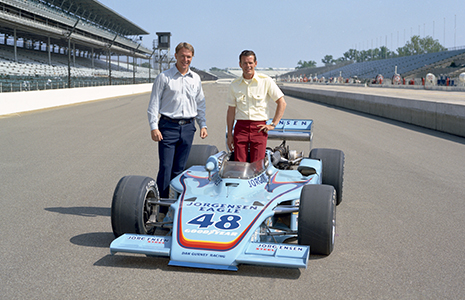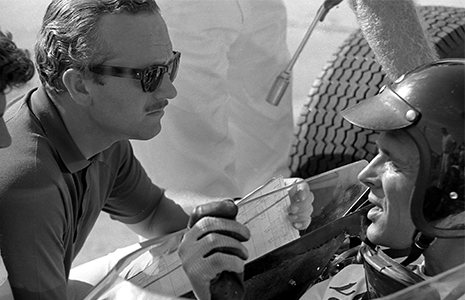Steeped in Gurney history, Hildebrand proud to commemorate it
APR 23, 2019
If you’re looking for what’s decent and righteous about social media – and that’s a strenuous search most days – drop by Facebook and visit Dan Gurney and the All American Racers Fan Group.
Once there, you won’t be bothered by fighting or politics or snark or any of the other darkness known to make social media uncomfortable. Instead, you’ll find what social media should be: a celebration, a shared collection of photos, stories, memories and respectful insight about a person whose vision, innovation and skill were just a small portion of his immense contribution to motorsports.
 You’ll also find a link to Monday’s news about JR Hildebrand’s choice of a car number for the 103rd Indianapolis 500 presented by Gainbridge. The news dropped Monday, and over at the Gurney fan group, it was met with a standing ovation. When he pulls on to Indianapolis Motor Speedway for testing Wednesday, Hildebrand will carry Gurney’s iconic No. 48.
You’ll also find a link to Monday’s news about JR Hildebrand’s choice of a car number for the 103rd Indianapolis 500 presented by Gainbridge. The news dropped Monday, and over at the Gurney fan group, it was met with a standing ovation. When he pulls on to Indianapolis Motor Speedway for testing Wednesday, Hildebrand will carry Gurney’s iconic No. 48.
Gurney first came into Hildebrand’s view in his youth, when Hildebrand’s dad, John, brought his son to vintage races. Young JR learned the Gurney legend back-to-front, starting with team ownership and working back to Gurney’s driving days.
“I had sort of a backward initiation to everything Dan Gurney, starting with him as a team owner and working backward through him and learning about what an innovator he was,” Hildebrand explained. “Almost last came real appreciation for what he did and what he was about as a race-car driver. I don’t think I really fully began to appreciate that until I was a pro. Then you start to understand it. Forget about all the Eagle (chassis design) stuff. Just look at his resume as a driver. In the end, that’s what I appreciate the most about him. For me, it’s such an overlooked part of his legacy.”
So complete and all-encompassing were Gurney’s overall contributions to the sport that his accomplishments as a driver occasionally are overshadowed. They shouldn’t be, because – as Hildebrand will attest – Gurney was one of the best whoever raced.
“You almost forget that he was one of the greatest drivers who ever lived – certainly one of the most accomplished Americans in motorsport history,” Hildebrand said. “When you wrap all of those things together, it’s an incredible legacy. He’s a little bit Jim Hall, a little bit Parnelli Jones and a little bit A.J. Foyt all mashed together. It’s an incredible story, if not anything else.”
The decision to honor Gurney through numerals morphed from last year’s honorary number at Indy. Then, Hildebrand’s Salesforce-sponsored Dreyer & Reinbold Chevrolet carried the No. 66 made famous by Mark Donohue. When Fernando Alonso decided to use No. 66 this year at Indy, Hildebrand chose Gurney’s 48, then laughed with Alonso about it.
See, it's all good that @alo_oficial took the 66 for this year... 😉⬇️ #48 https://t.co/gXhiKev9wk
— JR Hildebrand (@JRHildebrand) April 22, 2019
Hildebrand’s helmet features tributes to Dan Wheldon, Justin Wilson and Nicky Hayden. Last year, a tribute to Gurney was added. Only natural, then, that a change in car numbers would go in Gurney’s favor. For Hildebrand, Gurney’s career comes to life through photos, videos and stories.
“When you go back and look at old photos and videos of him, you come to appreciate that his peers had this immense respect for him,” Hildebrand said. “You can only imagine what’s being said when he’s sitting there looking sort of pensive on the back of a Lotus Indy car with Colin Chapman and Jim Clark, but for a race-car driver, that is the thing that defines how you think about your own career. It’s such a cool thing to look back on and see.”
(Gurney is shown below talking to the legendary Chapman from inside the Lotus at Indy in 1964.)
 Among the coolest are the cars. Gurney’s famed Eagles are the most beautiful and effective vehicles to grace the open-wheel genre. But there was so much more to Dan Gurney. He was the first driver to win in Formula One, Indy cars, NASCAR and sports cars. His win at the 24 Hours of Le Mans in 1967 with A.J. Foyt in a Ford GT40 is still considered the greatest American accomplishment at the famed endurance race.
Among the coolest are the cars. Gurney’s famed Eagles are the most beautiful and effective vehicles to grace the open-wheel genre. But there was so much more to Dan Gurney. He was the first driver to win in Formula One, Indy cars, NASCAR and sports cars. His win at the 24 Hours of Le Mans in 1967 with A.J. Foyt in a Ford GT40 is still considered the greatest American accomplishment at the famed endurance race.
He was the first F1 driver to wear a full-face helmet. He invented the Gurney flap and the Gurney bubble. The way drivers spray every moving thing on the podium with champagne after a race? That was Gurney’s invention, too. He finished second at Indy twice in the No. 48 car – in 1968 and 1969 – and third in 1970. Bobby Unser drove the No. 48 to victory in the 1975 Indy 500 (Gurney and Unser are shown above with the winning No. 48 Olsonite Eagle).
At the time, the dexterity and creativity wasn’t as widely recognized as it should have been. But now, with everything so close and changes so marginal, the Gurney era carries a sense of romanticism.
“There isn’t the ability to apply a macro approach from an engineering or design perspective that there was back then,” Hildebrand said. “That’s what I affectionately think of as the days of Dan Gurney. It’s kind of impossible, really, for anybody to exactly emulate what somebody accomplished or the way somebody operated in that period of time. That certainly doesn’t change the fact that I have massive appreciation for what that took.
“There’s still plenty of room for an engineer to put his stamp on the way the car works and the approach to setup, but it’s for hundredths (of a second) now, not for the ability to make huge changes. … I don’t think we’ll get back to that place, but in some ways, it makes it all the more cool and interesting to try to put yourself in the shoes of the guys who were doing it back then. It’s such an epic time in our sport. It showcased the ingenuity and imagination of the folks who were great at it.”
Before Gurney died in January 2018 at 86, Hildebrand had a chance to talk to his hero.
“I’ll never forget being able to talk about racing with him,” Hildebrand said. “I think everybody wishes they could’ve had a conversation with Dan Gurney. My helmet from last year had Dan in the 48. I think in some ways it was serendipitous that that’s where we ended up this year.”
A cheer has risen in response to the tribute. Over at the Dan Gurney fan group on Facebook, though, the response is more intense. It’s a heartfelt and appreciative. It’s a reliving of the past. It’s a full-on standing ovation.






















